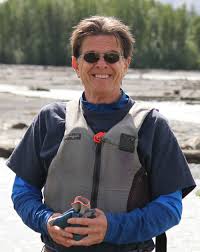How did the Little Books, Big Stories start?
Coffee was the first of the little books. I had written the story and a national magazine originally was going to publish it, but they backed off, said they didn’t publish “comic fiction.” A neighbor friend of mine, Siobhan Burns, who worked at Conde Nast in L.A., laid out the book for me, my old artist friend Andy Reidenbaugh drew that cool tin coffee cup for the cover and another friend of mine in publishing helped me with the first press run. I got enough publicity to generate orders to pay for the first production. I saw it was a viable concept and I developed a business plan from there.
Coffee is funny, but the story works on many levels.
I try to make all the books work on at least three planes: First, the story has to be funny. Second, the reader has to learn about whatever subject title is. Third, the story has to have a strong theme.
Coffee is definitely funny and every page has a description of some coffee. What’s the theme?
For those who haven’t read coffee, the story is about a caffeine addict who marries another caffeine addict and there whole life centers on coffee. When the man has to quit caffeine, the relationship spirals out of control.
“Spirals out of control” is an understatement about what happens in the story.
Well, yes. The theme of the story is if we build our relationships on externals, if that external disappears, there is nothing left. That’s why we have to build our relationships internally.
Cat was the next book.
Yes, but not intentionally. I was working on another project and my cat, Bouhaki, kept sitting on my keyboard and pushing her butt in my face. Every time I picked her up off my keyboard she would moan and groan and climb back with an intense look on her face. I had a flash of her suing me for alienation of affection and that was the seed for the story.
A cat takes her owner to cat court and sues him for alienation of affection. What’s the theme?
The theme is more of a question: Can we really change our lives and our behavior? The nameless protagonist has lived a failed love life, symbolized by his old girlfriend, Wendy. The stray kitten he finds on his doorstep symbolizes a new life for him and he succeeds until his old habits (Wendy) come back to sabotage his personal growth.
It rains during the entire story of Cat.
Yes. The book, like coffee, takes place in my hometown of Portland, Oregon, where it rained everyday most of my life. I always wanted to write down descriptions of the Portland rain and this was a perfect time.
“The rain pounded on the roof like a herd of buffalo.”
Exactly. Also, the rain brings a level of peril to the story. Anyone who has gone looking for an animal in the pouring rain can relate to the gut feelings the protagonist is feeling.
Tell us about Eagle.
I’ve worked as a river guide in the Chilkat Bald Eagle Preserve since 1991. I’m also what’s called a spieler, or speaker. I give up to 100 talks a year. When I first came to Alaska I didn’t feel comfortable giving the same spiel I heard so often, usually a mix of mostly information with a few standard jokes thrown in. I wanted visitors to be entertained and within that entertainment, informed as well. I started telling people what their life would be like if they were eagles; how they hunt, how they eat, how they sleep, how they romance. I wanted to write something that answered the basic questions everyone asked about eagles and was fun.
The story of Eagle, an eagle with a fear of commitment, is funny.
A story needs a driver and one of the best drivers is when the hero, human or not, goes against his nature. Findings tend to indicate eagles mate for life so I had Hal fall off his natural course, lose the female of his dreams and then fight to win her back.
What inspired Mrs. Claus?
Back when I was a lyricist, I wrote a song “A Pause for Mrs. Claus”, about how Mrs. Claus never got any respect or recognition. I wrote a draft about how Santa Claus and she met when they were young but the story didn’t work and it was a little dark. My significant other works in the corporate world and one day when she was talking about the issues a woman deals with in that world and the glass ceiling, I saw what Mrs. Claus
was all about. Thematically, I was inspired by a fight I had with my partner. One day she was unhappy with something I wasn’t doing and she told me how much she had given to me. When she was done, I told her that obviously she hadn’t given me anything because she was charging me for it now. There was the classic pause and overwhelming silence. Over the next few days I realized that, in my own way, I did the same thing.
Can we give unconditionally? That’s the theme of Mrs. Claus and that’s her journey in the story. Even though she has to go fairly dark to find her epiphany I tried to keep it as light as possible.
How do you decide the themes of the books?
I don’t usually know what the theme is until the 4th or 5th draft. The themes are important to the stories, but the themes are more important to me because they are challenges that intrigue me—can we really change? How do we define commitment in our lives? Why do we give and can we give freely?
Which takes us to the theme of Salmon.
Ulysses with scales. Sort of. A salmon rises above all the rest to overcome every obstacle except his destiny—to die after his mission of spawning. I had to put in the Dolly Salmon as an oracle to whom the fish wouldn’t listen. One of my favorites of the book series.
Tell us about Bear.
Bear was fun. The easiest way to tell the story was to go to one of biggest misconceptions about bears—that they are angry. To play off that, I wanted a bear that actually was angry. Angry toward his mother for abandoning him and angry toward the world for his troubles. The Anger Management Therapy was a natural driver and, also, my friend and editor of most of the books, Laurie, is also a therapist. She was a huge help with the therapy sessions.
There are dreams in all your books, but Bear had more than usual.
Sure. The story called for it and I worked very hard on those dreams. The dreams tell the story as much as the therapy sessions. Dreams are great storytelling tools, but they can blow up on you as a writer and you can lose your reader. But, yes, I love using dreams when I write even though I don’t consciously think about it. I’m writing and I go, hey, let’s put a dream scene here.
There was a big gap between Bear and Moose. How long does it take to write a little book like yours?
That’s not the first time someone has asked that. In every way, writing a short story is more challenging than a novel. A writer can cheat and use filler in a long piece. In a short story, done well, everything has to fit. Every sentence in one of my little books is there for a reason. There’s no fat, and I’m not happy until the story and each segment works.
The theme of Moose?
What is destiny and do we have any control over our destiny is the theme of the story. It took me a long time to make the Moose book work. Moose are huge herbivores in a carnivore world and, as one of the characters says, the sun begins to set on a moose the day it is born. All the moose in the story accept their destiny as being the hunted, but our hero challenges that destiny.
Al Gigas, your moose detective, has a great name. How did you come up with that?
Alces Alces Gigas is the largest of the seven species of moose in North America. Al Gigas. What a perfect name for a detective. All the books have inside jokes with the names, from the moose cow in Moose, Cervida, to the therapist, Chordata, in Bear.
What significance do the names Cervida and Chordata have to the stories?
Look it up.
Al Gigas, moose detective, is a great character. How did you develop him?
Modern detectives aren’t very interesting. I wanted Al to be a noir detective from the 40s and early 50s films. One of my oldest friends, Marc Louria, a San Francisco writer and script doctor, is the most knowledgeable person I know when it comes to story and especially the detective genre. He doesn’t edit any of my books but he talks me through concepts. Marc was essential in making Mrs. Claus work.
And Wolf is next?
Yes. The aerial shooting of wolves is sickening. I’ve wanted to write a book from the wolf perspective to honor the wolf but I didn’t have the story until I got the idea for a wolf going into the Wolf Protection Program and changing his identity as he pretends to be a domestic dog.
The theme of Wolf?
You’ll see.
When are you going to write a big book?
Anybody can write a big book. Go into any bookstore and all you see is big books. Not everybody can write a little book. There are too many big books with little stories. I write little books with big stories.

